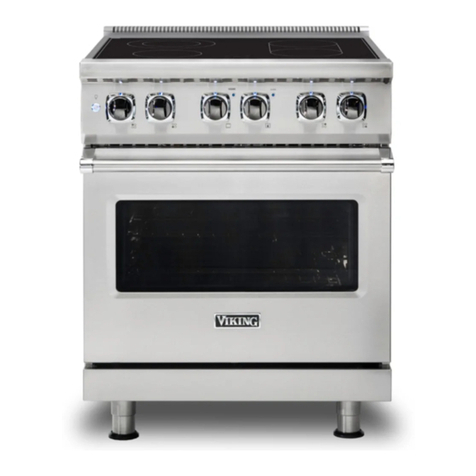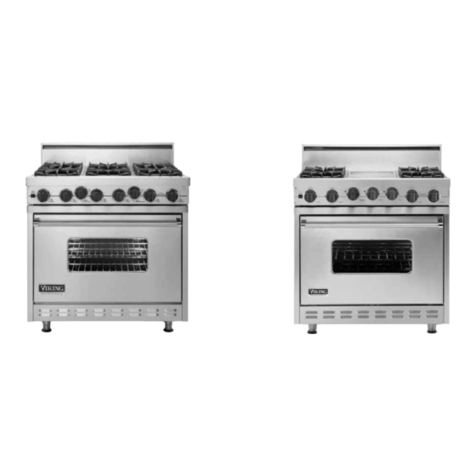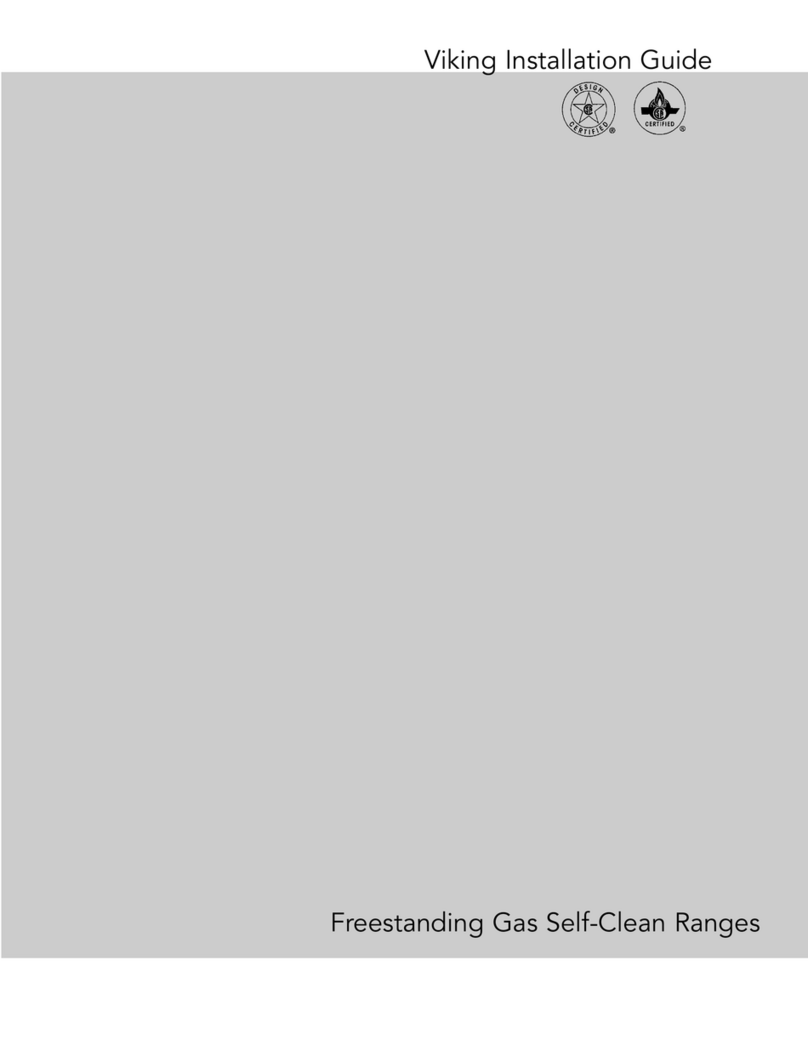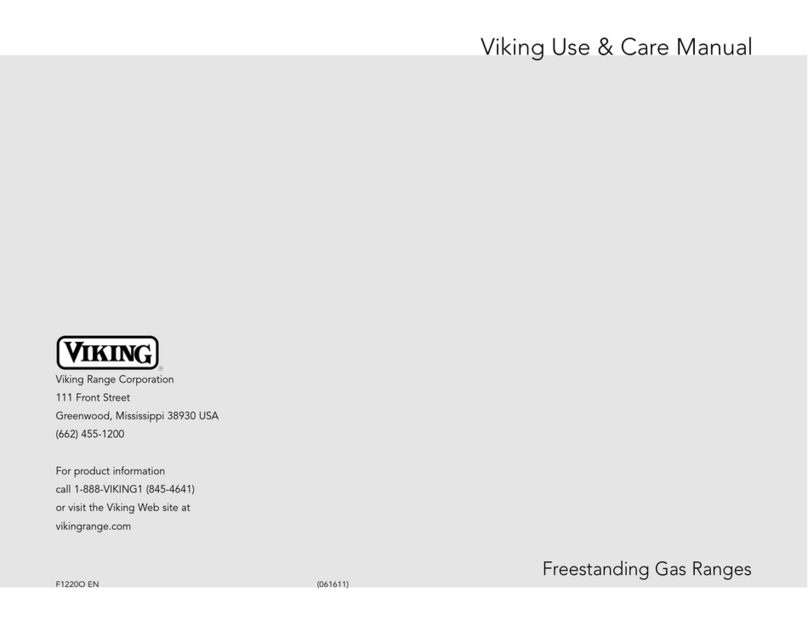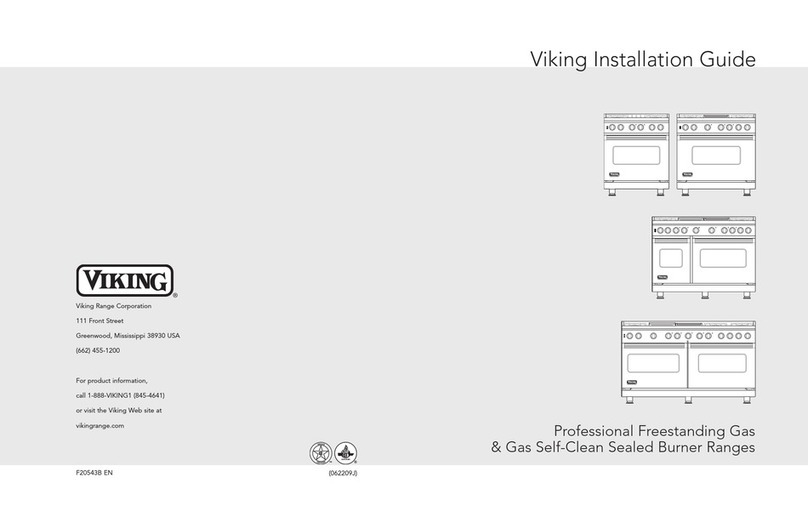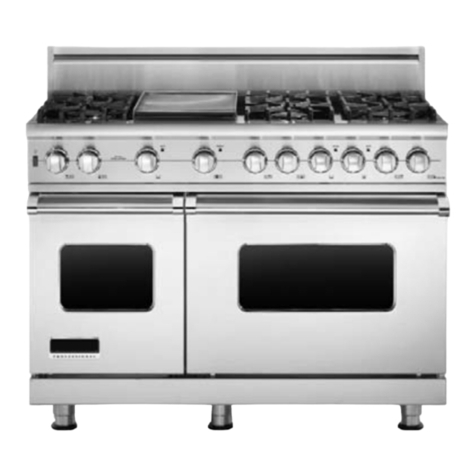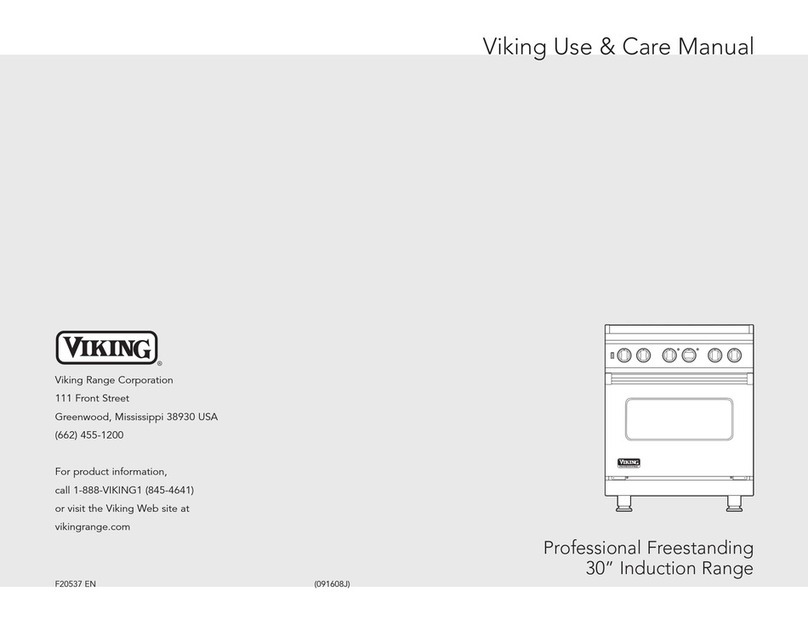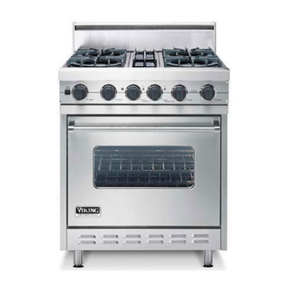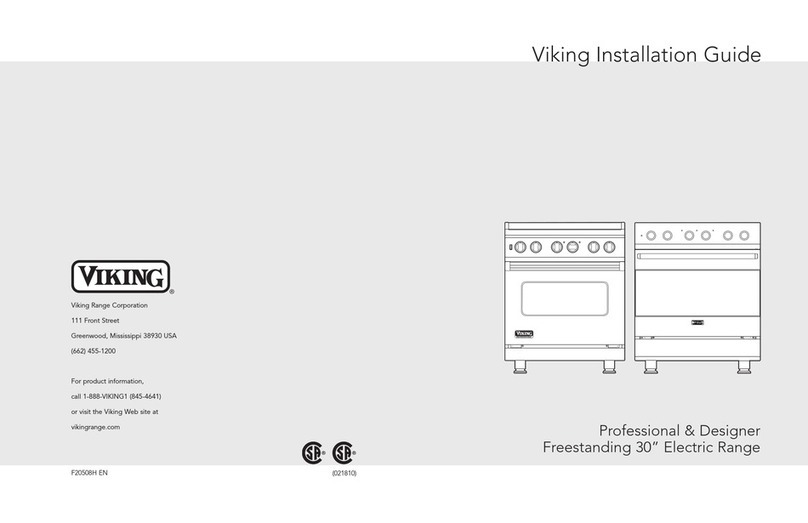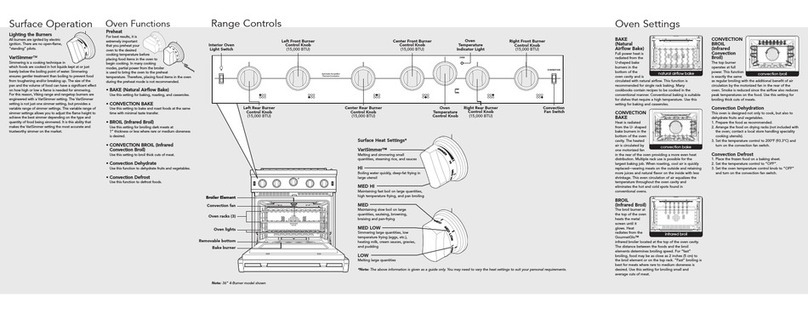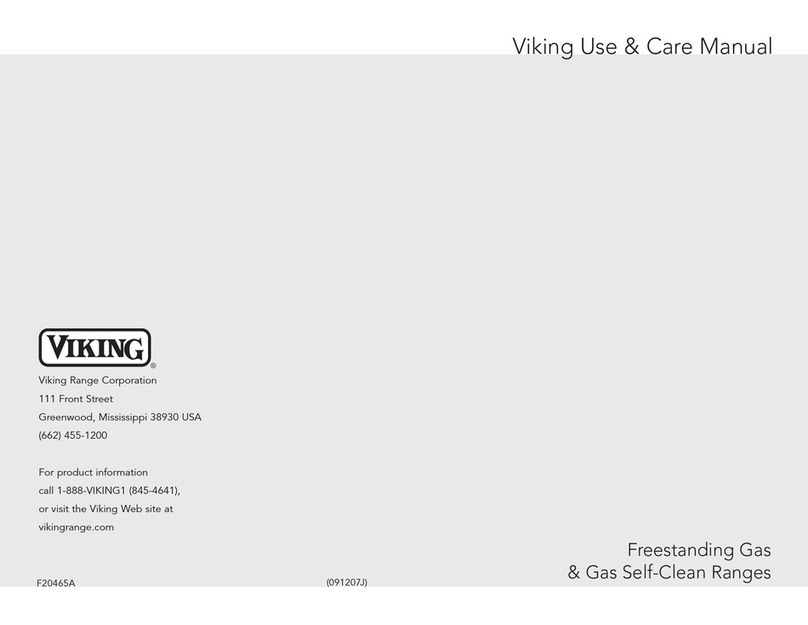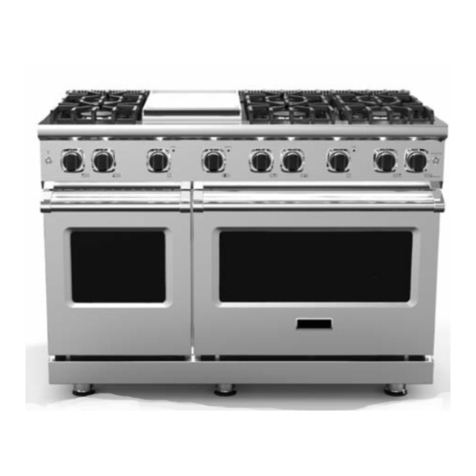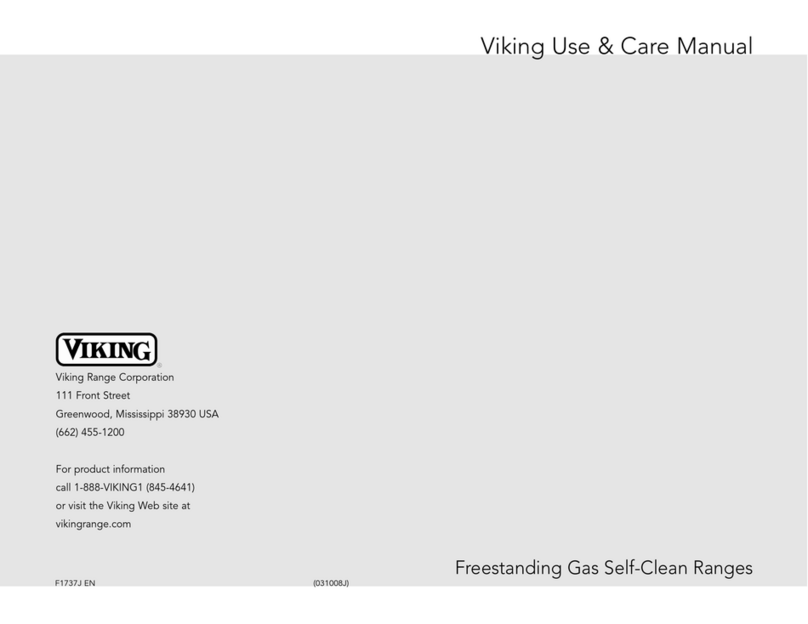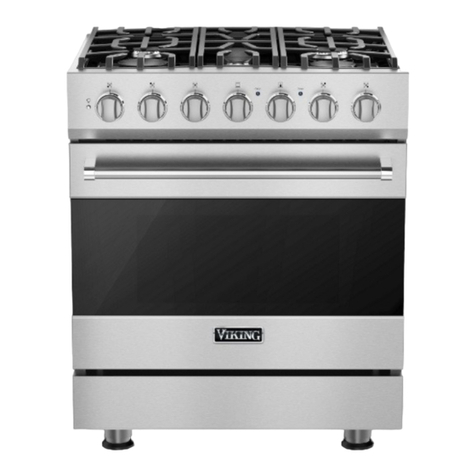Viking Installation Summary
Note: I the eve t electro ic capabilities or i ter et access is ot available, please HALT the i stallatio
process u til pri ted docume ts are available. You will receive, free of charge, a complete set of
pri ted docume ts by co tacti g Viki g Customer Service at 1-888-Viki g1 (845-4641).
Designer Freestanding
30” Dual Fuel Range
F20650 EN (091009J)
VIKING RANGE CORPORATION
111 Front Street • Greenwood Mississippi 38930
USA • (662) 455-1200
IMPORTANT– Please Read and Follow
• Before beginning please read these instructions
completely and carefully.
•DO NOT remove permanently affixed labels
warnings or plates from product. This may void
the warranty.
• All local and national codes and ordinances must
be observed. Installation must conform with local
codes or in the absence of codes the National Fuel
Gas Code ANSI Z223.1 NFPA54-latest edition.
• The installer must leave these instructions with the
consumer who should retain for local inspector’s use
and for future reference.
In Canada: Installation must be in accordance with the
current CAN/CGA B149.1 & 2 Gas Installation codes
and/or local codes. Electrical installation must be in
accordance with the current CSA C22.1 Canadian
Electrical Codes Part 1 and/or local codes.
In Massachus tts: All gas products must be installed
by a “Massachusetts” licensed plumber or gasfitter. A
“T” type handle manual valve must be installed in the
gas supply line to the appliance.
DA N G E R
H z rds or uns fe pr ctices
which WILL result in severe person l
injury or de th
Your s fety nd the s fety of others is
very import nt.
e have provided many important safety
messages in this manual and on your
appliance. Always read and obey all
safety messages.
This is the safety alert symbol. This
symbol alerts you to hazards that
can kill or hurt you and others.
All safety messages will be preceded by
the safety alert symbol and the word
“DANGER,” “ ARNING” or “CAUTION.”
These words mean:
WA R N I N G
H z rds or uns fe pr ctices
which COULD result in severe person l
injury or de th
CA U T I O N
H z rds or uns fe pr ctices which
COULD result in minor person l injury or
property d m ge
All safety messages will identify the
hazard, tell you how to reduce the chance
of injury, and tell you what can happen if
the instructions are not followed.
D A N G E R
FIRE/EXPLOSION
HAZARD
IF THE INFORMATION IN THIS
MANUAL IS NOT FOLLOWED
EXACTLY, A FIRE OR EXPLOSION MAY
RESULT CAUSING PROPERTY DAMAGE,
PERSONAL INJURY, OR DEATH.
•DO NOT store or use gasoline or other
flammable vapors and liquids in the vicinity
of this or any other appliance.
• WHAT TO DO IF YOU SMELL GAS:
–DO NOT try to light any appliance.
–DO NOT touch any electrical switch.
–DO NOT use any phone in your building.
–Immediately call your gas supplier from a
neighbor’s phone.
–Follow the gas supplier’s instructions.
–If you cannot reach your gas supplier,
call the fire department.
• Installation and service must be performed
by a qualified installer, service agency, or
the gas supplier.
DA N G E R
ELECTRICAL SHOCK
HAZARD
To avoid risk of electrical shock,
personal injury or death; verify
your appliance has been properly grounded in
accordance with local codes or in absence of
codes, with the National Electrical Code
(NEC), ANSI/NFPA 70-latest edition.
W A R N I N G
CHEMICAL HAZARD
To avoid risk of property
damage and/or personal injury
or death; this appliance is not to
be used as a heating source.
• Benzene is a chemical which is part of the
gas supply to this cooking product, which is
consumed in the flames during combustion.
Exposure to a small amount of benzene is
possible if a gas leak occurs. Formaldehyde
and soot are by-products of incomplete
combustion.
• This appliance contains or produces
chemicals which can cause serious injury or
death and which are known to the state of
California to cause cancer, birth defects or
other reproductive harm. To reduce the risk
from substances in the fuel or from
fuel combustion make sure this appliance
is installed, operated, and maintained in
accordance to the instructions in this
document.
WA R N I N G
MOVING HAZARD
To avoid risk of severe personal
injury; this appliance requires
two or more personnel while
handling and moving. Possible use of
appliance moving devices is recommended.
D A N G E R
GAS LEAK HAZARD
To avoid risk of personal injury
or death; leak testing of the
appliance must be conducted
according to the manufacturer’s
instructions. Before placing appliance in
operation, always check for gas leaks with
soapy water solution.
• DO NOT USE AN OPEN FLAME TO
CHECK FOR GAS LEAKS.
W A R N I N G
TIPPING HAZARD
To reduce the risk of property
damage or personal injury;
install anti-tipping device
provided in accordance with the
installation instructions in this
document. Device must be
engaged properly to prevent
product from tipping over.
• This range can tip.
• Injuries to persons can result.
• Install anti-tip device packed with range.
• See installation instructions.
C A U T I O N
BURN HAZARD
To avoid risk of personal injury;
the use of cabinets for storage
above the appliance may result
in a potential burn hazard. Combustible
items may ignite, metallic items may become
hot and cause burns. If a cabinet storage is
to be provided the risk can be reduced by
installing a rangehood that projects
horizontally a minimum 5” (12.7 cm) beyond
the bottom of cabinets.
NOTICE
DO NOT use the handle or oven door to lift
the range. Remove door before installation
to ensure that it is not used to lift the unit.
DO NOT lift or carry the door by the handle.
Removing the door must be done by your
dealer, a qualified licensed plumber, or
certified gas installer.
IMPORTANT– Please Read and Follow (cont.)
Performance
Checklist
A qualified installer should carry out the following
checks:
NCheck top burner ignition.
See drawing for proper
flame height on HI. The
low flame should light at every
port.
NCheck oven bake function—
bake element on full power
center and outside broil elements at partial power.
NConvection bake function—bake and broil
elements the same with the convection fan on.
NCheck TruConvec™ function—TruConvec
element (behind convection fan cover) on and
convection fan on.
NCheck HI broil function–both broil elements at
full power.
NCheck LOW broil function—inner broil
element only.
NCheck convection broil function—both broil
elements at full power with convection fan on.
NCheck self-clean function—door will lock in
approximately 30 seconds the center and outside
broil elements will turn on and the bake element
will turn on at partial power. Check broil elements
through window to make sure they are on then
abort self-clean cycle to unlock door.
NOTICE
hen conducting performance test, DO NOT
run self-clean cycle for more than 10
minutes with oven racks inside oven. This
could cause them to discolor due to the high
temperature required for self-cleaning.
Electrical & Gas
Requirements (cont.)
Manual shut-off valv :
This installer-supplied valve must be installed in the gas
service line before the appliance in the gas stream and
in a location where it can be reached quickly in the
event of an emergency.
In Massachus tts: A “T” handle type manual
valve must be installed in the gas supply line to the
appliance.
IMPORTANT: Any conv rsion r quir d must b
p rform d by your d al r or a qualifi d lic ns d
plumb r or gas s rvic company. Please provide the
service person with this manual before work begins.
Pr ssur R gulator:
• All heavy-duty commercial type cooking equipment
must have a pressure regulator on the incoming
service line for safe and efficient operation since
service pressure may fluctuate with local demand.
External regulators are not required on this range
since a regulator is built into each unit at the factory.
Under no condition bypass this built-in regulator.
• Manifold pressure should be checked with a
manometer natural gas requires 5.0” W.C.P. and LP
gas requires 10.0” W.C.P. Incoming line pressure
upstream from the regulator must be 1” W.C.P.
higher than the manifold pressure in order to check
the regulator. The regulator used on this range can
withstand a maximum input pressure of 1/2” PSI
(14.0” W.C.P.). If the line pressure is in excess of that
amount a step down regulator will be required.
• The appliance must be disconnected from the gas
supply piping system during any pressure testing of
that system.
Fl xibl Conn ctions:
If the unit is to be installed with flexible couplings
and/or quick-disconnect fittings the installer must use
a heavy-duty AGA design-certified flexible connector of
at least 1/2” (1.3 cm) ID NPT (with suitable strain reliefs)
in compliance with ANSI Z21.41 and Z21.69.
In Canada: CAN 1-6 10-88 metal connectors for
gas appliances and CAN 1-6.9 M79 quick disconnect
devices for use with gas fuel.
In Massachus tts: This appliance must be installed
with a 36” (3-foot) long flexible gas connector.
Electrical & Gas Requirements
El ctrical R quir m nts
This product is manufactured with the neutral terminal
connected to the cabinet. Use a 3-wire agency
approved power supply kit with closed loop terminals
rated per the National Electric Code ANSI/NFPA 70-
latest edition (See Rating chart below).
RATING* Sp cifi d Rating of Pow r Supply Cod Kit
and Circuit Prot ction
120/240 Volts 120/208 Volts Amps
12.5 - 16.5 KW 9.2 - 12.5 KW 40 or 50
16.5 - 17.5 KW 12.5 - 13.5 KW 50
*The National Electric Code calculation for Electrical
Load is less than the Total Connected Electrical Load
listed on the model/serial rating plate.
A GFI shall be used if required by NFPA-70 (National
Electric Code), federal/state/local laws, or local
ordinances
•The required use of a GFI is normally related to the
location of a receptacle with respect to any
significant sources of water or moisture.
• Viking Range Corporation will NOT warranty any
problems resulting from GFI outlets which are not
installed properly or do not meet the requirements
below.
If the use of a GFI is required it should be:
•Of the receptacle type (breaker type or portable
type NOT recommended)
•Used with permanent wiring only (temporary or
portable wiring NOT recommended)
•On a dedicated circuit (no other receptacles
switches or loads in the circuit)
• Connected to a standard breaker of appropriate
size (GFI breaker of the same size NOT
recommended)
•Rated for Class A (5 mA +/- 1 mA trip current) as
per UL 943 standard
•In good condition and free from any loose-fitting
gaskets (if applicable in outdoor situations)
• Protected from moisture (water steam high humidity)
as much as reasonably possible
Commonw alth of Massachus tts:
•Installations and r pairs must b pr form d by a
qualifi d or lic ns d contractor, plumb r, or gas
fitt r, qualified or licensed by the state province or
region where this appliance is being installed.
•Us only gas shut-off valv s approv d for us
within the state province or region where this
appliance is being installed.
•A Fl xibl gas conn ctor, wh n us d, must not
xc d 3’ (.9m).
California Proposition 65
Burning gas cooking fuel generates some by-products
that are on the list of substances known to cause cancer
or reproductive harm. To minimize exposure to these
substances always operate this unit according to the
instructions contained in this book and provide good
ventilation
Gas Conn ction
The gas supply (service) line must be the same size or
greater than the inlet line of the appliance. This range
uses a 1/2” (1.3 cm) ID NPT (Sch40) inlet. Sealant on all
pipe joints must be resistive to LP gas.
Th rang is d sign d sp cifically for natural gas
or liquid propan (LP) gas. B for b ginning
installation v rify that th mod l is compatibl
with th int nd d gas supply.
W A R N I N G
ELECTRICAL SHOCK
HAZARD
To avoid the risk of electrical
shock, personal injury or death;
verify electrical power is turned off at the
breaker box and gas supply is turned off until
the oven is installed and ready to operate,
installation by an authorized installer only.
C A U T I O N
To prevent possible damage to cabinets
and cabinet finishes, use only materials and
finishes that will not discolor or delaminate
and will withstand temperatures up to
194° F (90° C). Heat and moisture resistant
adhesive must be used if the product is to be
installed in laminated cabinetry. Check with
your builder or cabinet supplier to make sure
that the materials meet these requirements.


